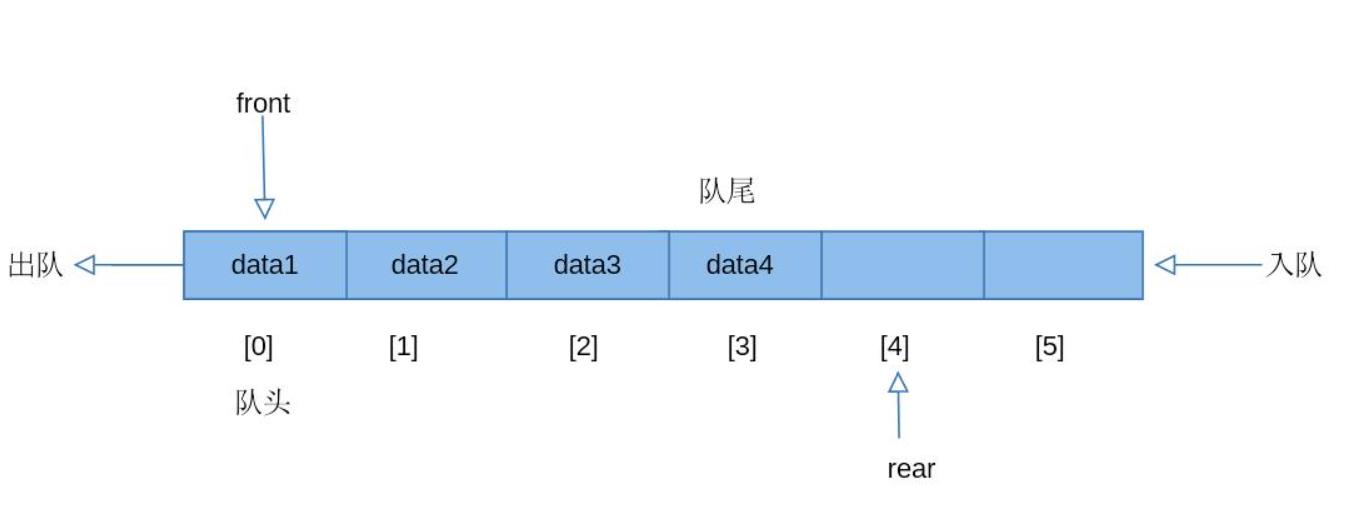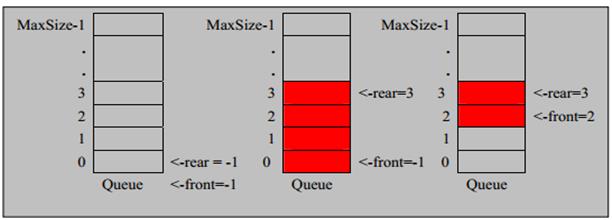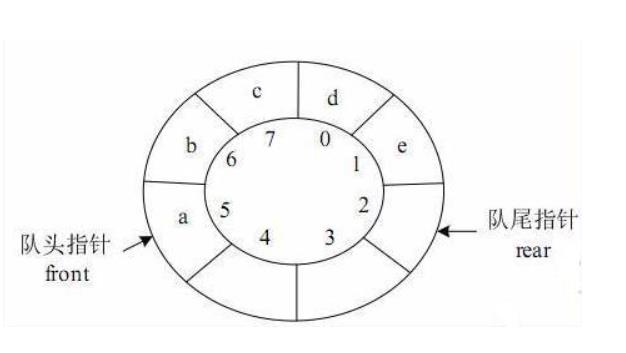Java用数组和链表实现队列
Posted 活跃的咸鱼
tags:
篇首语:本文由小常识网(cha138.com)小编为大家整理,主要介绍了Java用数组和链表实现队列相关的知识,希望对你有一定的参考价值。
学过数据结构的人都了解过队列这一常见数据结构。下面我用数组和链表实现队列的两种方式做一个总结。
队列介绍
队列是一种特殊的线性表,特殊之处在于它只允许在表的前端(front)进行删除操作,而在表的后端(rear)进行插入操作,和栈一样,队列是一种操作受限制的线性表。进行插入操作的端称为队尾,进行删除操作的端称为队头。队列中没有元素时,称为空队列。
队列的数据元素又称为队列元素。在队列中插入一个队列元素称为入队,从队列中删除一个队列元素称为出队。因为队列只允许在一端插入,在另一端删除,所以只有最早进入队列的元素才能最先从队列中删除,故队列又称为先进先出(FIFO—first in first out)线性表。如下所示

数组实现顺序队列
队列本身是有序列表,使用数组来声明队列如下图:Maxsize代表队列最大容量
因为队列的输入是从队尾输出是从队首来处理的,所以需要两个变量来代表前后两端,如下图front代表队首,rear代表队尾。front随着数据的输出而改变,rear随着数据的输入而改变。

其实现方法如下:
class ArrayQueue {
private int maxSize; // 表示数组的最大容量
private int front; // 队列头
private int rear; // 队列尾
private int[] arr; // 该数据用于存放数据, 模拟队列
// 创建队列的构造器
public ArrayQueue(int arrMaxSize) {
maxSize = arrMaxSize;
arr = new int[maxSize];
front = -1; // 指向队列头部,分析出front是指向队列头的前一个位置.
rear = -1; // 指向队列尾,指向队列尾的数据(即就是队列最后一个数据)
}
// 判断队列是否满
public boolean isFull() {
return rear == maxSize - 1;
}
// 判断队列是否为空
public boolean isEmpty() {
return rear == front;
}
// 添加数据到队列
public void addQueue(int n) {
// 判断队列是否满
if (isFull()) {
System.out.println("队列满,不能加入数据~");
return;
}
rear++; // 让rear 后移
arr[rear] = n;
}
// 获取队列的数据, 出队列
public int getQueue() {
// 判断队列是否空
if (isEmpty()) {
// 通过抛出异常
throw new RuntimeException("队列空,不能取数据");
}
front++; // front后移
return arr[front];
}
// 显示队列的所有数据
public void showQueue() {
// 遍历
if (isEmpty()) {
System.out.println("队列空的,没有数据~~");
return;
}
for (int i = 0; i < arr.length; i++) {
System.out.printf("arr[%d]=%d\\n", i, arr[i]);
}
}
// 显示队列的头数据, 注意不是取出数据
public int headQueue() {
// 判断
if (isEmpty()) {
throw new RuntimeException("队列空的,没有数据~~");
}
return arr[front + 1];
}
}
测试如下:
public static void main(String[] args) {
Queue queue = new Queue(7);
queue.addQueue(1);
queue.addQueue(7);
queue.addQueue(4);
queue.addQueue(2);
queue.addQueue(9);
queue.showQueue();
System.out.println(queue.isEmpty());
System.out.println(queue.isFull());
System.out.println(queue.headQueue());
System.out.println(queue.getQueue());
}
输出:
arr[0]=1
arr[1]=7
arr[2]=4
arr[3]=2
arr[4]=9
arr[5]=0
arr[6]=0
false
false
1
1
数组模拟环形队列
上述顺序队列只能使用一次并不能达到复用的效果。
何为环形队列
在实际使用队列时,为了使队列空间能重复使用,往往对队列的使用方法稍加改进:无论插入或删除,一旦rear指针增1或front指针增1 时超出了所分配的队列空间,就让它指向这片连续空间的起始位置。自己真从MaxSize-1增1变到0,可用取余运算rear%MaxSize和front%MaxSize来实现。这实际上是把队列空间想象成一个环形空间,环形空间中的存储单元循环使用,用这种方法管理的队列也就称为循环队列。

实现代码如下:
class CircleArray {
private int maxSize; // 表示数组的最大容量
//front 变量的含义做一个调整: front 就指向队列的第一个元素, 也就是说 arr[front] 就是队列的第一个元素
//front 的初始值 = 0
private int front;
//rear 变量的含义做一个调整:rear 指向队列的最后一个元素的后一个位置. 因为希望空出一个空间做为约定.
//rear 的初始值 = 0
private int rear; // 队列尾
private int[] arr; // 该数据用于存放数据, 模拟队列
public CircleArray(int arrMaxSize) {
maxSize = arrMaxSize;
arr = new int[maxSize];
}
// 判断队列是否满
public boolean isFull() {
return (rear + 1) % maxSize == front;
}
// 判断队列是否为空
public boolean isEmpty() {
return rear == front;
}
// 添加数据到队列
public void addQueue(int n) {
// 判断队列是否满
if (isFull()) {
System.out.println("队列满,不能加入数据~");
return;
}
//直接将数据加入
arr[rear] = n;
//将 rear 后移, 这里必须考虑取模
rear = (rear + 1) % maxSize;
}
// 获取队列的数据, 出队列
public int getQueue() {
// 判断队列是否空
if (isEmpty()) {
// 通过抛出异常
throw new RuntimeException("队列空,不能取数据");
}
// 这里需要分析出 front是指向队列的第一个元素
// 1. 先把 front 对应的值保留到一个临时变量
// 2. 将 front 后移, 考虑取模
// 3. 将临时保存的变量返回
int value = arr[front];
front = (front + 1) % maxSize;
return value;
}
// 显示队列的所有数据
public void showQueue() {
// 遍历
if (isEmpty()) {
System.out.println("队列空的,没有数据~~");
return;
}
// 思路:从front开始遍历,遍历多少个元素
for (int i = front; i < front + size() ; i++) {
System.out.printf("arr[%d]=%d\\n", i % maxSize, arr[i % maxSize]);
}
}
// 求出当前队列有效数据的个数
public int size() {
// rear = 2
// front = 1
// maxSize = 3
return (rear + maxSize - front) % maxSize;
}
// 显示队列的头数据, 注意不是取出数据
public int headQueue() {
// 判断
if (isEmpty()) {
throw new RuntimeException("队列空的,没有数据~~");
}
return arr[front];
}
}
链表实现队列
public interface Queue <E>{
int getSize();//获得队列长度
boolean isEmpty();//队列是否为空
void enQueue(E e);//入队
E deQueue();//出队
E getHead();//获得队头元素
void traverse();//遍历队列
}
public class LinkedListQueue<E> implements Queue<E>{
private Node head,tail;
private int size;
public LinkedListQueue() {
head=tail=new Node();
size=0;
}
private class Node{
public E e;
public Node next;
public Node(E e) {
this.e = e;
}
public Node() {
}
public Node(E e, Node next) {
this.e = e;
this.next = next;
}
}
@Override
public int getSize() {
return size;
}
@Override
public boolean isEmpty() {
return size==0;
}
@Override
public void enQueue(E e) {
if(tail==null){
//尾部插入一个元素
tail=new Node(e);
head=tail;
}else {
tail.next=new Node(e);
//队尾后移
tail=tail.next;
}
size++;
}
@Override
public E deQueue() {
if (isEmpty()) {
throw new RuntimeException("empty queue");
}
//辅助指针
Node temp=head;
//头指针后移
head=head.next;
temp.next=null;
if(head==null){
tail=null;
}
size--;
return temp.e;
}
@Override
public E getHead() {
if(isEmpty()) {
throw new RuntimeException("empty queue");
}
return head.e;
}
//遍历队列
public void traverse(){
Node temp=head;
if(temp==null) {
throw new RuntimeException("empty queue");
}
while (true){
//遍历到最后
if (temp==null){
break;
}
System.out.println("the element is:"+temp.e);
temp=temp.next;//向后遍历
}
}
}
public class Test {
public static void main(String[] args) {
LinkedListQueue<String> listQueue = new LinkedListQueue<>();
// Queue
listQueue.enQueue("a");
listQueue.enQueue("b");
listQueue.enQueue("c");
listQueue.enQueue("d");
System.out.println(listQueue.isEmpty());
System.out.println(listQueue.getSize());
listQueue.deQueue();
listQueue.traverse();
}
}
测试结果:
false
4
the element is:a
the element is:b
the element is:c
the element is:d
以上是关于Java用数组和链表实现队列的主要内容,如果未能解决你的问题,请参考以下文章